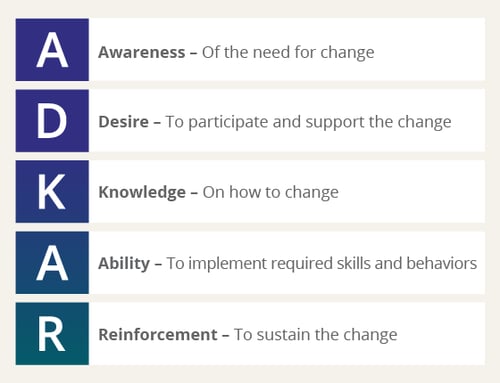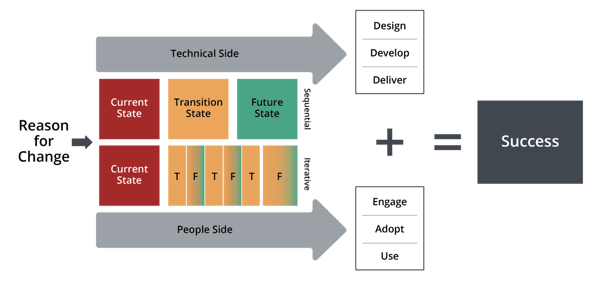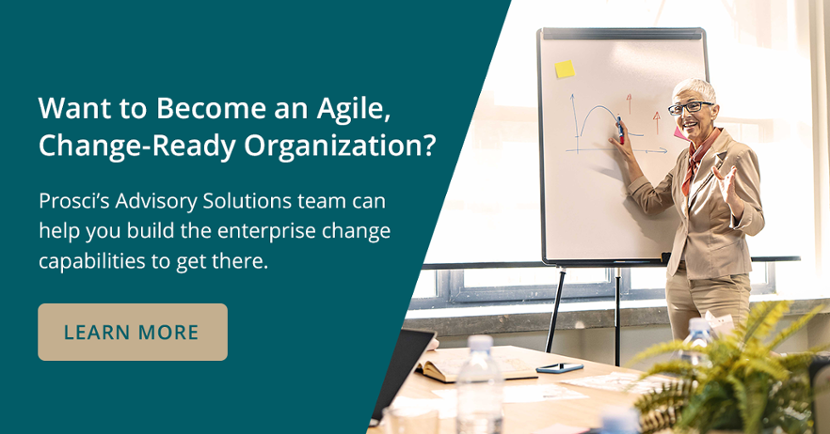How To Manage Technology Changes Holistically

6 Mins
Updated: March 7, 2025
Published: July 12, 2023

Most people think about change management for technology as implementing software and training on how to use it. But it's not just about that. It's about looking at the full business solution, including changes to the processes and tasks that will impact your employees and other stakeholders within and outside the organization.
It’s important to remember that technology is the enabler to achieve the desired business goals, which usually requires a shift or an evolution in a process to better support the business outcomes. Managing technology holistically is key to accomplishing this—and it achieves better outcomes faster, and often at lower cost.
Technology Changes
Start With Process Changes
The first step in managing a technology change is to understand the process changes taking place which the technology will support. Those changes to processes are what the impacted people and groups need to understand first, even if it's just changing one task. People also need to understand why it's changing, how it impacts them, and how the business will benefit.
The software training on functionality is secondary. It is much easier for users of a tool to adopt to the technology when they engage and know why they're changing, what they will do every day, and how the change will impact them. Once they know all that, understanding how to click the keys to put information into a tool is secondary.
What processes are changing? What processes can be introduced before installing a technology? During technology changes, such as implementing a new ERP system, you often need to change processes that don’t relate directly to the technology itself. It’s easy for project teams to overlook these. To understand all impacts a change can have on people, you need to evaluate every process to determine whether it will change, and if so, whether that change is supported by the technology or supported by people—or both.
In fact, during any technology implementation, clients often ask us to recommend other process changes to make them better, faster or easier. We always address this because it’s all part of the same value chain. Looking at a business solution holistically helps ensure that the “why” behind doing the change has a better chance of succeeding, including meeting the project’s objectives and realizing its organizational benefits.
How to Start Change Management for an
ERP System Implementation
As an example, let’s look at how to start managing change holistically when implementing a new ERP system.
1. Ask why the change is being made
This is essential to defining success for the project. The reason organizations install a technology is usually to improve efficiencies, get a better view across the organization, improve the view of the customer, address a problem, or capitalize on an opportunity.
When you need to articulate the purpose and benefits of technology changes to stakeholders and employees, Prosci's AI-powered tool, Kaiya, can be a big help. Kaiya can help you find clarity quickly using Prosci's expertise and research-based insights, and provide assistance with crafting clear, compelling messages about the change initiative.
2. Identify job-related processes impacted by the technology change
Once we understand their “why,” we need to determine which processes are being impacted by the change to a new ERP system. Most organizations start in the finance area. When you start to change your financial procedures and processes, you need to keep the technology in the background.
During our requirements gathering with a client, we also inquire about what is changing at a process level. (Remember, we’ll get to the technology later). Should accounting be doing this process? Can we make things easier by eliminating or adding a task, or changing who does the task?
Once we know what’s changing at the process level, we start to see the impacts on user groups. The questions we ask will uncover the process changes that employees need to adopt in their daily work.
10 Aspects of Change Impact
%20(1).jpg?width=600&height=323&name=10-Aspects-Change-Impact-Model-150%20(2)%20(1).jpg)
3. Connect the change to business results
Next, we use the 4 P's: Project, Purpose, Particulars and People. This enables us to make the connection between the project objective (installing the ERP technology) and the organizational benefits (making a process more efficient, cost effective, etc.). This also gives us a clearer view of the client organization and aligns our work with their business objectives.
4. Assess risks
We also evaluate the risks associated with implementing the ERP system. If our assessment shows that an ERP implementation is high risk, we have to ask whether the organization is change ready or change resistant. It is certainly disruptive to put in a whole new system, but it’s even more disruptive when you're also changing the tasks people need to do in their jobs. For impacted groups, that feels like a double whammy. And if our assessment reveals a highly resistant organization, the impact is magnified.
The key is that technology changes require a two-phased approach. First, we enable impacted groups as they go through one ADKAR journey for the job-related processes, and then we go through another ADKAR journey to support changes associated with the actual software.
The Prosci ADKAR® Model

Essential Questions
During Technology Changes
Whenever we work with clients on ERP and other technology implementations, we must understand the people-side impacts. Have we thought about the people beyond just functional training on the tool? Do people know why the company is making the technology change? Is the sponsor aware that managing the change effectively is not only about installing the software, but also about changing a process to achieve business objectives? Is the project manager aware of and aligned with that? And does the project team understand the people-side impacts of the change in terms of how they drive or undermine their desired outcomes?
Often, organizations decide to put an ERP without asking these and other critical questions. There's a definite business reason to upgrade or put in a technology, and teams need to think about how they will communicate that with people and teams.
A change management practitioner’s facilitation skills come into play here because any change will cause people to ask, “How does this impact me?” or “What’s in it for me?” (WIIFM). If you tell people they only have to learn a new software, you will set yourself up for problems because you're taking away a job task or giving them extra tasks to do, and that has little to do with the technology.
Change Management With Agile and
Iterative Solutions Development
At times, project managers will object to doing change management on ERP and other technology implementations because they believe it conflicts with the concept of Agile and other iterative approaches. But only half of the solution is about designing, developing and deploying the technology. That’s the technical side of the change.
On the people side of the change, we want the employees to be engaged, and to adopt and use the solution as readily as possible. We accomplish this by putting the customer (impacted groups) at the center of the change. This is about maximizing return on investment and minimizing the amount of time it takes to achieve it.

American football offers a good analogy for a successful change to an ERP system. In football, you have a quarterback and a receiver on the field. The quarterback gets out there, sees the lay of the land, sees a solution, and throws the ball—but if the receiver is not ready, they miss the pass. And so, they try and try again, which is wasted time, effort and money.
Let’s say the quarterback sees a solution, and the receiver sees the quarterback setting up the solution. The receiver knows where to go, so when the ball is thrown, they are where they need to be to catch it. The pass is complete. There's no time wasted. Now they get to the second down more swiftly and move toward their goal more swiftly.
The quarterback is the project manager, and the receiver is the employee. The project manager is “throwing the pass” by developing a solution. At the same time, the change practitioner is getting people ready to “catch” that solution and understand why it’s being thrown a particular way.

How do you effectively prepare your people to catch the solution? In terms of the ADKAR Model, people impacted by the ERP system change need to have Awareness of the need for change and Desire to participate in the change by the time the technology is ready and not after. And people should have already overcome much, if not all, of their resistance. They should also be finished with the necessary training—for both job-related process changes and how to use the technology itself.
So, when the project manager flips the switch and the technology goes live, people are ready. They know why the project is happening. They understand how it impacts them on a daily basis. And they have had the functional training to leverage the tool. They may not be completely proficient, but they will feel prepared and equipped for success. Managing changes using this holistic approach not only saves time and effort, but also eliminates the costs of rework and significant resistance at go-live.
Getting Started With
Holistic Technology Changes
To act on these ideas, change teams need to come together at the beginning of a project and work together as one team. This takes specific effort and collaboration from three key parties:
- Sponsor must agree that we are delivering a holistic solution
This is the starting point and often the biggest hurdle to overcome. Briefing the sponsor builds their awareness that change management is not just training and communications. When they talk about needed to implement technology on a certain timeline, be sure you ask how they will get people to adopt and use it.
- Change practitioner must understand the technology
You don’t need to know how to code, but you do need to invest in learning enough about the solution and the phases it takes to develop a technical solution.
- Project managers must understand process changes
Understanding the process changes and the impacts they will have on people is critical to developing the right solution to help ensure the tool is used in a timely manner in the way it was intended.
When you consider speed of adoption, ultimate utilization, and proficiency, a holistic approach is faster and far more effective at achieving the return on investment and desired business outcomes the technology changes are intended to support. A true holistic solution is about looking at the change from all sides—not just from a technology side, not just from a business side, not just from a process side, not just from the users’ side, not just from a “get it done” side. It takes all parties working together toward the same goal.



